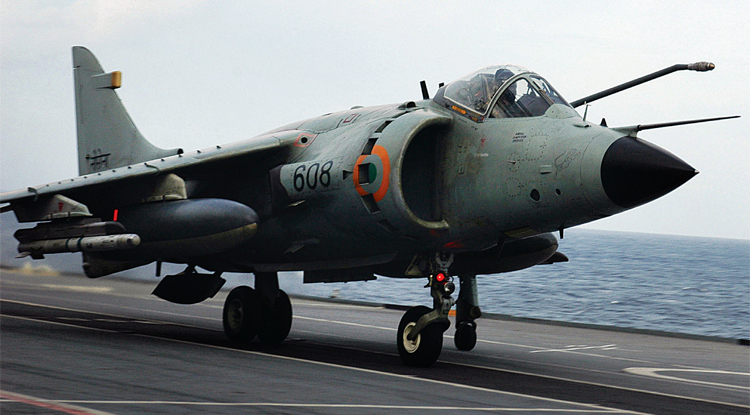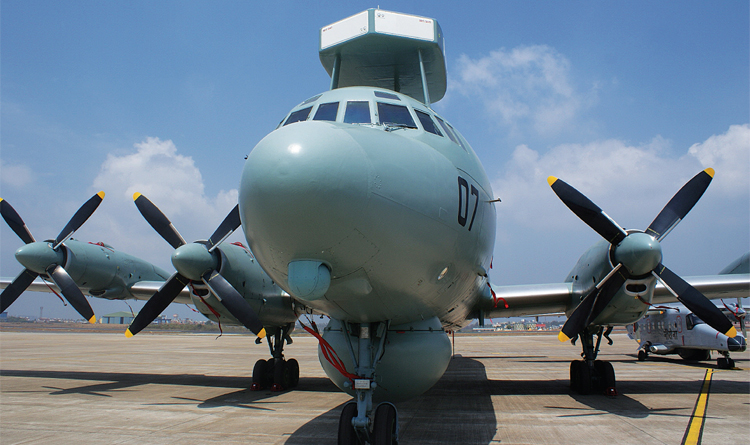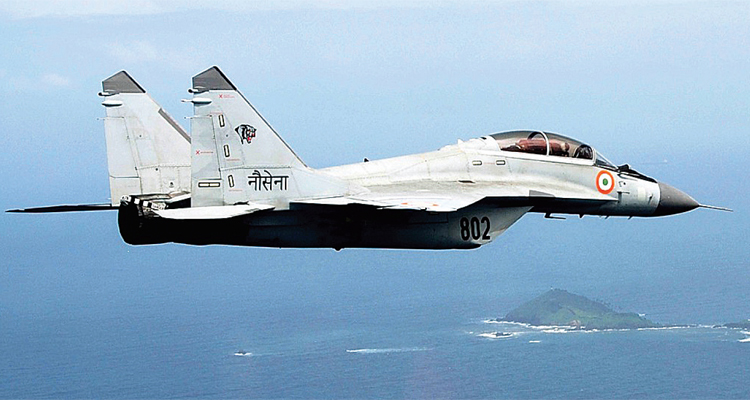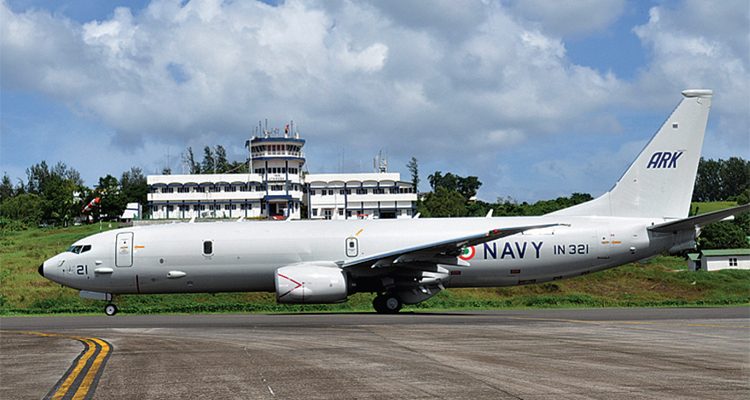INDIAN ARMED FORCES CHIEFS ON
OUR RELENTLESS AND FOCUSED PUBLISHING EFFORTS

SP Guide Publications puts forth a well compiled articulation of issues, pursuits and accomplishments of the Indian Army, over the years

I am confident that SP Guide Publications would continue to inform, inspire and influence.

My compliments to SP Guide Publications for informative and credible reportage on contemporary aerospace issues over the past six decades.
LEAD STORY
Decade of the Maritime Air Power
Maritime Air Power is applied in the maritime theatre to fulfill maritime objectives, as well as achieving the necessary degree of air control for maritime operations within this area of interest. Maritime Air Power has undergone historic transition in the decade gone by due to the fundamental shift in its role.
 | The Author is former Chief of Integrated Defence Staff. A naval aviator of fighter stream, he has flown over 2700 hours and steered naval aviation acquisition as the Assistant Chief of Naval Staff. He retired in 2014 as the Flag Officer Commanding-in-Chief of the Western Naval Command. |

Comprehensive National Air Power
It will be appropriate to mention the writings of Clausewitz, who suggested that war consists of a trinity; made up of people, the government and the armed forces. War comprises and balances between creative forces (symbolized by the armed forces action), rational forces (symbolized by the government) and emotional forces (symbolized by the people). Essentially it means that the Armed Forces are separable from the people (who do not take part in fighting) and from the government, which leads the war. Obviously Clausewitz’s analysis was influenced by the military and political context in which he lived. Now we are into 21st century. It is not so anymore.
Civilians were usually absent from theatre or the battlefield either because the battle occurred in relatively unpopulated area or they fled the area prior to onset of war. Today, this linearity has diminished severely. Now the civilians and civilian objectives are intermingled with military objectives. The valid targets which could not feasibly be struck in the past, now become vulnerable. The universe of strikeable targets multiplies and therefore the potential of collateral damage and incidental injury while still achieving military objectives.
Prime Minister Modi while addressing the Combined Commanders in 2015 said “beyond the immediate, we are facing a future where security challenges will be less predictable; situations will evolve and change swiftly; technological changes will make response more difficult to keep pace with. Threats may be known but the enemy may be invisible” He further said “full scale war may become rare, but force will remain an instrument of deterrence influencing behavior and the duration of conflicts will be shorter”.

Effectively, to handle today’s changed nature of warfare, comprehensive national power will have to be brought to bear to achieve political objectives in the short timeframe that would be available. While doing so, nations will ensure least collateral damage and incidental injury since military and civilian objectives will be difficult to discern, media will control dissemination and regulate public reaction. Clearly, precision engagements will underline military tactics and strategy which highlights the centrality of Air Power. It will consist of several systems of systems that enable military forces to locate the objectives or targets, provide responsive command and control, generate the desired effect, assess the level of success, and retain flexibility to reengage with the precision required. It is in this context that the maritime arm of the National Air Power has gained significance in the present decade while the land based Air Force’s air power has had a much longer wait towards sharpening their teeth what is truly desirable in the present changed nature of warfare. Indian Air Force deserves credit for being the alma mater of all varieties of military aviation in India. This article is a tribute to the alma mater of aviation from one of their frontiers – Maritime.
We are in the new decade, it is still counting. Induction of Tejas in Light Combat role, additional Su-30 MKIs, induction of Rafael fighters complement of C-17/C-130 strategic transport aircraft, Mi-17 VE and Chinook heavy lift helicopters along with Apache attack helicopters induction are some important additions. The deliberation on manufacturing of advanced fighters under ‘Make in India’ drive is also in progress. In the absence of newer inductions IAF has done the country proud by innovating new avenues of application of air power; landing of Su-30 aircraft closer to NE and Northern borders, Demonstrating ability of strategic airlift upto DBO, supporting fighter operations outside the country, large number of HADR operations and maintaining highest levels of surveillance and response mechanisms in turbulent atmosphere around us.
Precision engagements will underline military tactics and strategy which highlights the centrality of Air Power
Maritime air power has undergone historic transition in the decade gone by. There has been fundamental shift in the philosophy of maritime patrol, anti-submarine and anti-surface warfare processes and carrier borne fighter operations. Prospects of strengthening anti-submarine rotary wing fleet, increasing surveillance bubble in the Indian Ocean by addition of more long range and Medium Range Maritime patrol aircraft, utility and multi-role helicopters (Sikorsky MH-60), drones and commissioning of the first indigenous aircraft carrier are very encouraging. We examine these fundamental shifts in concept and philosophies.
Long Range Maritime Patrol and Antisubmarine Warfare
From the year 1976, IAF relinquished the role of long range maritime patrol task to the Navy by transferring the Super Constellation aircraft. This was first occasion for the Navy to operate four engined long endurance aircraft. It was all new experience for the crew to be flying extended long hours and from an air station, maintaining alertness on the radar and visual watch, transfer data information manually to Maritime Operation Centre, criss cross number of FIR boundaries, operate close to open airspace of neighboring countries and in the process get intercepted by advanced fighter aircraft mainly of the US Navy. Aircrew developed the desired skills to handle the new ways in the changed operational environment. Earlier, carrier borne Alize provided surveillance in maritime patrol role which was adequate for domain awareness around the carrier task force, the MORs played limited role. With the induction of Super Constellation aircraft, long range maritime patrol became a reality. The MORs (maritime operations rooms) were upgraded to handle larger volumes of information over much larger area in the IOR. The IAF also began exercising their role of shore based anti shipping strike in coordination with the Maritime Patrol aircraft, leaving the Carrier Task Force to operate further away from EEZ in pursuance of power projection and making impact warfare over land in distant lands. It made the Navy truly blue water. However, shore based and shipborne air ASW operation still remained an enigma.

The Super Constellation aircraft was replaced by IL-38 aircraft which had capability of both the maritime patrol as well as ASW at long ranges giving the Navy ability to track submarines in far off seas particularly at vulnerable choke points. The aircraft was more modern than the Constellation, turboprop propulsion, had advanced electronics and ability to attack a submarine if it was confirmed to be hostile (being equipped with torpedoes and depth bombs). It still lacked very long legs in terms of endurance given the expanse of IOR and anti ship strike capability. Navy modified the aircraft to carry Sea Eagle anti ship missiles. Also, concept of shepherding shore based fighter aircraft for anti ship strike was developed which kept the adversary further away from areas of our interest. The IL-38 was later supplemented by one squadron of Tu-142 aircraft from erstwhile Soviet Union which had very extended endurance and was capable of much higher speeds to reach the patrol area quickly and exit as fast. The Bear, as it was known, was the fastest turboprop aircraft in the world which was difficult to intercept. The concept of gambit tactics was developed by the Navy to push the adversary further away into their own waters and prevent their venturing anywhere close to Carrier task force. The Navy stabilized on sound concept of reconnaissance ahead of departing fleet from harbours and subsequent sanitisation in the direction of advance, bringing offensive operation in the realm of possibilities. The Tu-142 was also equipped with better sonobuoys which could localise a submarine with much greater accuracy, a prerequisite against nuclear powered submarines. Higher endurance gave it the capability to keep much larger areas of IOR under surveillance. The combination of Sea Harrier fighter jets operating from two aircraft carriers i.e. Vikrant and Viraat gave the Navy capability to intercept MPA and adversary’s maritime strike aircraft, conduct deep penetration strike into enemy heartland as also shepherded strike on surface targets which were out of strike radius of the shore based aircraft. These three decades witnessed the Navy truly ruling the waves in the IOR, becoming net security provider to friendly nations and littorals. Navy was frequently being called upon by number of countries for their EEZ surveillance and escort assistance any where and everywhere in the IOR.
Arrival of Vikramaditya and MiG-29K
The Naval planners were sanguine of the emerging security paradigm in the Indian Ocean and limitations of Sea Harrier Vikrant/Viraat combination towards fulfilling the role of the Navy in the future. The Sea Harrier was nearing obsolescence and so were the two aircraft carriers. By selecting the Sea Harrier as replacement to Sea Hawk, Navy had drifted away from tailhook fighter aviation operational philosophy, primarily because our carriers were of smaller size and no tail hook aircraft similar to Sea Hawk was available which could see through the life of the carrier. STOVL Sea Harrier met those national aspirations in the IOR in addition to the jump in technology, both power plant and avionics/weapons that it brought in the Navy. Naval Aviators adapted to the maintenance and operational philosophy of STOVL very professionally and maintained Indian supremacy in the IOR for thirty years. This was aided by the second aircraft carrier Viraat from 1986. Later, Vikrant was modified with 9.75 ski jump giving the Sea Harrier slightly longer legs. Since, both the carriers have been decommissioned at the end of their technical life.

The geopolitical dynamics was altering its character in and around IOR. Indian economy was doing better and so was the need to protect it and the SLOCs in far off seas. Gradually, India was becoming a major regional player in the Comity of nations. Soviet empire had collapsed. Terrorism had become order of the day. US, the sole superpower, was engrossed in war on terror against Al Qaida and associates in and around Afghanistan. This preoccupation of the US and down slide in Russian economy gave China adequate opportunity to rise, both economically and militarily. Indian Naval planners were watching these developments as also the growing complicity between China and Pakistan which could hurt Indian National interests in the future. Therefore, there was need to strengthen maritime offensive capability to keep the adversary’s assets under pressure far off from our areas of interest and act as deterrence against any misadventure on land borders as well as along SLOCs. This necessitated two fundamental conceptual changes both in Maritime Patrol/ASW and fighter operation domains. In the MR ASW task, there was need to develop capability to reach an area of concern quickly, locate the adversary accurately and prosecute with strength.
The Tupolev 142 and IL-38 were past their prime. After the collapse of the Soviet empire, Russian industry had nothing better on offer to replace these fuel guzzlers. Their industry was unable to support the inventory that we had. Also, after the fall of Soviet Union there were no new proven platforms which were joining the Russian Armed Forces. This created a situation wherein Indian Navy would had to contend with older technology and that too at very high price tag.
There was necessity to enhance Navy’s maritime domain awareness to the next higher level with the ability to locate and prosecute hostile targets
This was the time when Indo US bilateral relations were witnessing upswing. Simultaneously the presence of Chinese nuclear submarines in the IOR was becoming more frequent. There was necessity to enhance Navy’s maritime domain awareness to next higher level and therefore to find Maritime Patrol/ASW aircraft which had precessional ability to locate and prosecute hostile surface and sub surface targets. US was in the process of developing Boeing P8 Poseidon aircraft for MPA/ASW role for their Navy. Given our improved bilateral relations and convergence in security perceptions with the US in the IOR, the Navy convinced the government of the day to look westwards for acquiring this capability. It was this foresight that lead to signing of contract and induction of P8-I aircraft which now forms the backbone of all operations in the IOR today. This was first major Defence platform acquisition from the US. Naval Aviation was moving from turboprop propulsion to jet engine propelled Boeing platform. The avionics and weapons are contemporary and most advanced in the world. Eight aircraft are already in our inventory and four more on the way. This has given the Navy capability which she never had before. The anti submarine sensors are the best available and attack suite extremely compatible. The 360 degrees radar is backed by very efficient fire control system for the Harpoon ASM giving her very credible anti surface vessel capability. These aircraft deployed at choke points e.g. St of Malacca, Hormuz and Gulf of Aden provide very best of surveillance and if required offensive capability against hostile/threatening surface or nuclear powered sub surface platforms. This capability was needed considering the increasing presence of Chinese nuclear submarines and decision of Chinese to arm Pakistan with eight submarines possibly AIP powered. The P8-I is fast and has long loiter time on task. It extends the maritime domain awareness bubble to virtually entire IOR. The real time data link through own communication satellite GSAT-7 has made the Maritime Operations Centres much inclusive in warfare, making it possible for Commanders ashore to monitor the local surface picture of far off seas and provide valuable inputs to the aircraft Commander in prosecution. It has also given India the ease of operation in support of IOR littorals from their airfields given that Boeing is a commercial platform and majority of nations can support their operations.
Return of the Tailhook Fighters
As mentioned earlier, the VSTOL technology had seemingly peaked as far as ordnance carrying capability and radius of action was concerned. Navy saw this coming. Coupled with this was the need for increasing India’s area of influence to commensurate with her growing stature in the developing geopolitical landscape. The Chinese assertion in the South China Sea, Commissioning of Liaoning and their rejection of tribunal of the PCA verdict in the SCS are some pointers which indicated the times which lie ahead in the IOR. It was a very well strategised decision to acquire platforms which gave the Navy capability of operating in the entire IOR with ease and the punch which would act as deterrence to prevent war. What was required was both the aircraft carrier and fighter aircraft, which would have ability to operate in seas of our interests, penetrate deep into adversary’s heartland if required and remain on task long enough to counter any retaliatory action.

Much delayed decision to acquire Soviet era Gorshkov and convert her into aircraft carrier was a major shift in carrier operation philosophy of the Navy. The Gorshkov, renamed Vikramaditya, was to become STOBAR (short take off but arrested recovery) carrier thereby shifting back to Tailhook fighters from STOVL Sea Harriers. The aircraft chosen was MiG-29K. The aircraft was in very prototype form in Russia and therefore essentially a development aircraft. There were large number of differences from similar sounding Russian variant MiG-29 which the IAF flies. The aircraft chosen had fly by wire flight control system, more modular engine requiring lesser maintenance thereby increasing aircraft availability on account of saving time on servicing. The aircraft was truly supersonic, which would give the Navy ability to react quickly and intercept any hostile intruder. Endurance being high, MiG-29K also gave the capability to strike deep into adversary’s heartland giving relief to the IAF in performance of their task of anti shipping strike both within and outside the strike radius of shore based fighters.
The pilots and engineers adapted very well to Tailhook operation and handling of supersonic flight regime. Vikramaditya arrived from Murmansk in Russia and anchored off her home port on January 7, 2014. That was the day when the reach and power of India in the maritime domain increased manifold. A new squadron called Black Panthers (303 Squadron) was commissioned to embark the carrier. Later, on May 11, 2016, the STOVL fighters Sea Harriers were de-inducted from the Navy and White Tigers (300 Squadron) were also armed with the MiG-29K aircraft, making India Navy capable of embarking two embarking fighter squadrons for the first time since independence. This would also keep the Navy ready with an operational fighter squadron when indigenous carrier Vikrant gets commissioned. There was a time when Navy had one Sea Harrier squadron and two aircraft carriers and now we have two MiG-29K squadrons for one aircraft carrier! The aircraft can also operate from air stations ashore in support of maritime tasks. This points at the reach of air power that Indian Navy has acquired when it is seen in conjunction with much enlarged MDA made possible with the induction of P8-I and UAVs. There is possibility of inducting Predator armed UAVs now that fundamental agreements LEMOA, COMCASA and BECA have been signed with the US.
The government’s look/act east policy along with existing threat packed western seaboard, gets confidently addressed by creation of these abilities. It also helps the IAF in utilising the fighter assets committed for maritime role for many other operational tasks in a time when their assets are needed for deterrence against two front threat of conflict. We are well on the way to being net security provider in the IOR in the changing Indo Asia Pacific security challenges and construct. Creation of CDS (Chief of Defence Staff) and Theatre Commands on the cards we are likely to see many changes in our war fighting philosophy which could lead to making maritime air power even more robust.





